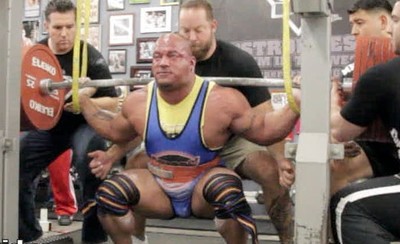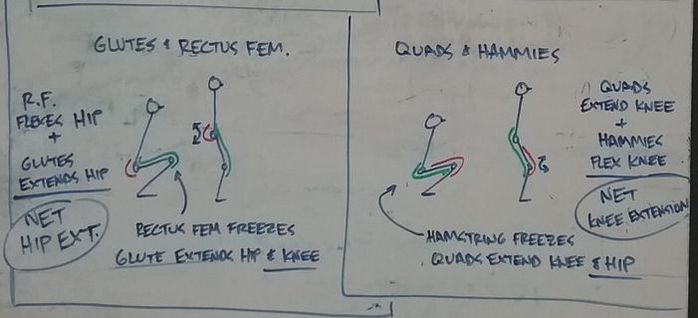|
With the advent of the internet and, eventually, social media, powerlifting has climbed to new heights of popularity. As the talent pool swells with new competitors, the bar continues to rise. Every aspect of the sport has received 'more': more genetically talented lifters, more athletes who started younger, more access to meets and training facilities, and, of course, more improvements in technique and training. In the last few decades of this powerlifting bubble, mad bro-scientists have been toiling away in the iron lab in an attempt to engineer more efficient movement patters, and thus stake their claim on a legacy in the sport. One of the by products of this engineering is the insistence that a hip dominant squat is the most effective way to move the heaviest possible load from point A to point B. Lifters began foregoing the deep knee bend that had been forming world champions for a century in favor of box squats, reverse hypers, glute ham raises, good mornings, and other posterior-heavy movements. Popular culture took hold and did what it does best; water down complex ideas for easy digestion by the masses. This invariably results in a church-like following that proselytizes the way, the truth, and the light without any awareness of the founding principles that bore the idea in the first place. Geared lifting has since fallen by the wayside in favor of the classic belt and wrap combo, and many of the original members of the Church of Lowbar have since begun to doubt. From an analytical standpoint, the reasons used to justify a hip dominant squat seem compelling. The hip, when compared to the knee, is a bigger joint surrounded by stronger muscles. A wider setup will shorten the total distance the bar must traverse, lowering the total amount of work done. Keeping the knees out in a wide stance allows the hips to stay closer to the center of mass, shortening the moment arm between the weight and the hip, thus improving leverage. Essentially, the squat is treated like a back-supported deadlift, and guys like Louie Simmons and the boys at Westside were able to train the two lifts interchangeably. The hip back, shins vertical, spread the floor commands placed the load on the posterior by a much wider degree and simulated a stroke that carried over directly to a pull of the floor. If you doubt the action of wide stance squat work on the deadlift, spend 6 weeks doing strict wide stance box squats for repeating sets of 4 and get back to me. The setup also potentiated the gear that was used: triple-ply Kevlar squat suits simply would not yield enough to allow depth with a narrow stance, regardless of how much weight was on the bar. Everything about the hip-dominant setup seemed to fit. So why the dissent? Quads and the World's Best Squat PerformancesWe have three broad eras of lifting to evaluate: the early decades of powerlifting up through the 1980's, the modern equipped age spanning the late 1980's to mid 2000's, and the current 'belt and sleeves' state of powerlifting. The early decades describe powerlifting's maturation as a sport, which was not unlike the wild west. I've heard stories of guys in the 70s and 80's wearing tight denim daisy dukes under their singlets and wrapping tennis balls behind their knees. It's no surprise that around the late 80's, the first 'power suits' were available that added substantial poundage to the lifters total. After 20 years of ridiculous advances in equipment in the geared front, powerlifting received a groundswell of participation from newbies either transitioning from Crossfit or looking for filler for their Instagram accounts. This generation of new blood rejected the gear in favor of fundamental roots, even resulting in the creation of divisions that banned knee wraps. If we look at world class performances in each of these three eras, we will see the wide stance setup prevalent in raw contests around the geared lifting era moreso than the eras before or after. Both eras pre and post multiply lifting saw more squats high bar and narrow than slow, grinded, low bar squats. Don't believe me? This article by Greg Knuckols addresses a study done in the 1970s that found world class squatters stayed more upright than their second and third class counterparts. The best raw squats of all time were done with medium/narrow stance in a relatively upright position. Kazmaier, Karwoski, Hatfield, Lilliebridge, Malanichev.... the list goes on. Dan Green highlighted his evolution beyond Westside principles and the hard lessons he had to learn on his way to being one of the greats in his article West of Westside. Point #8 proves the point in just a few sentences: hip dominant or not, big quads squat big weights. In point #9, Dan writes further about Konstantin Pozdeev out-squatting him by 200lbs in an early meet: “Where I’d always squatted with a wide stance with my butt back, he stood more upright with a close stance and allowed his knees to travel way out in front of his feet.... If I kept squatting with my knees out and back and sitting my hips way back I was only going to scratch away and make modest PRs but I would never add 200 pounds if I didn’t overhaul my squat.” Now, no rule is absolute and there are definitely other considerations to make regarding squat setup. First and foremost, you cannot outsmart your own anthropomorphy. Your limbs are exactly as long as they are and, barring extreme surgery, that will never change. It is not practical for someone with uniquely long legs and a short boxy torso to stay upright during a squat if the goal is to move a maximal load. For bodybuilding, yes. For Olympic lifting, yes. For powerlifting, no. Guys like Steve Goggins folded over like brief cases because that was the most efficient way for their uniquely lengthed limbs to work. Guys like Blaine Sumner and David Douglas posses superb hip mobility, likely due to the actual shape of their hips, which allows substantial depth to be met with a wide stance. And guys like Donnie Thompson and Henry Thomason squatted a lot of weight with a geared setup because they trained geared for so many years and, all things being equal, no other factor can compensate for years spent practicing a specific pattern. But assuming that you are not one of the 5% of outliers with exceptionally long legs (exceptionally short legs make staying upright easier) and that you have no desire to have three of your best buddies cram you into a denim singlet, your chosen setup should reflect a best guess of what is optimal. To determine that, let's take a look at how the human body actually executes a squat. For the purposes of this discussion, we will ignore every contributing muscle above the waist. The muscles of the abdominals, obliques, erectors, and upper back all contract isometrically to maintain position. While they put out great effort, they do not act on the hip or knee, so they are not responsible for actively moving your body through space. The main movers we will discuss are the glutes and hamstrings (primary hip extensors) along with the quads and rectus femoris (primary knee extensors) How the Hamstrings & Rectus Femoris Work: |
Archives |
















 RSS Feed
RSS Feed
